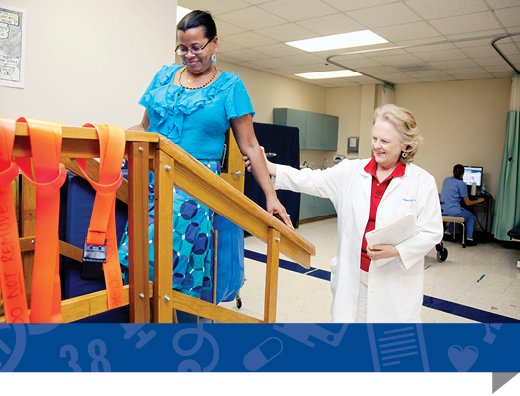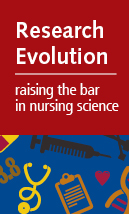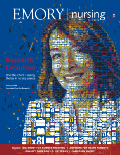A Powerful Antidote

"As nurses, we're advancing the tools we have to keep patients moving in their daily lives. Nurses are in the unique spot to give patients a different but realistic way to approach their abilities." — Becky Gary (above right)
By Kerry Ludlam
Heart failure patients gain back their lives through exercise
|
|
Telling a person in heart failure that he or she needs to exercise might sound counterintuitive. But, as Becky Gary PhD RN FAHA FAAN has found, it is one of the best things for them.
An associate professor in the School of Nursing, Gary has been at the helm of several studies exploring the benefits of physical activity for people with heart failure. As one of the leading causes of cardiac disability, heart failure is on the rise, largely because of an aging population and advances in diagnostic tools for earlier detection and treatment. Coupled with an inactive lifestyle, heart failure often leads to muscle atrophy, loss of strength, and deconditioning.
"Heart failure patients already have a diminished aerobic capacity," says Gary. "When they're not active, they begin to lose strength and muscle mass, eventually leading to aggressive body-wasting."
Gary's interest in these patients began close to home. As a child, she watched various family members deal with the challenges of cardiovascular disease, with several developing heart failure. They often were sedentary, partly because of their disease, and challenged to do even the simplest of everyday tasks. That stuck with her, shaping her life's work.
"Heart disease killed most of my aunts and uncles," she says. "But for those it didn't, it limited their quality of life so much that it was almost like not living at all."
Gary's family connection to heart failure, coupled with a lifelong interest in geriatrics, led her to pursue research to improve symptom severity and quality of life for patients with cardiovascular disease, especially those who are older. "My work is the combination of two loves," she says.
Traditionally, heart failure patients have been treated with a combination of medications and procedures, but as Gary found in a 2011 study funded by the Emory Heart and Vascular Center, physical activity also can be a powerful antidote. Gary and colleagues followed 24 heart failure patients at Emory Healthcare through a home-based exercise program that included aerobic and resistance training. While previous studies have evaluated heart failure patients through endurance testing on a treadmill, their trial is one of the first to use a physical function test to measure upper and lower body strength, flexibility, balance, and coordination. These often are strong indicators of a patient's ability to function in everyday settings.
After assessing their ability to do certain household tasks such as climbing stairs, unloading a clothes dryer, and reaching items on a shelf, Gary found that heart failure patients were dramatically underperforming in even the simplest tasks.
"Although the patients knew they were getting weaker, they were unaware of how bad the problem really was," she says. "They didn't know how they compared with healthy individuals, so they were accepting their declining abilities as part of their medical condition. It wasn't just that they felt sick. They also couldn't do the things they needed or wanted to do. We wanted to show them that it didn't have to be that way."
Over the next 12 weeks, study participants performed a combined aerobic and resistance program five days a week. They recorded their physical activity through an exercise calendar, a heart rate monitor, and a pedometer. Gary and her team also visited patients at home.
"We went to visit the patients once a week so that we could talk to them about their progress," says Gary. "The patients really responded to the visits, and it gave us a sense of the patient's home environment. With a home-based program, patients tend to be more adherent. When they're more adherent, they have more success, which in turn builds their confidence."
After completing the exercise program, study participants performed the household tasks again, this time with more success.
"What we found was that being physically active improves many functions of heart failure patients," says Gary. "Improving their physical abilities—their everyday activities—really can reduce symptom severity, stave off depression, and improve their overall quality of life."
So what exactly does exercise do for a heart failure patient?
"Exercise changes a lot of the peripheral vascular and the musculoskeletal adaptations that occur with heart failure," Gary explains. "Patients with heart failure start out with 50% less cardiac output, which means that their muscles are not receiving as much blood as they should be. Most of the heart failure disease severity markers have been shown over time to decrease with exercise. Our hope is to improve muscle function and delay disability for as long as possible."
Gary also has studied depression in heart failure patients. Supported by an American Heart Association Beginning Grant-in-Aid award, she found that aerobic exercise combined with cognitive behavioral therapy may improve depressive symptoms in depressed heart failure patients, proving that exercise is key in persons with heart failure, both physically and mentally.
"The physical and the psychological go together," says Gary. "This sense that they've lost the life they have always known can lead to depression, which can in turn cause more physical symptoms. It's truly a downward spiral."
She hopes that her findings will change both the way that heart failure patients look at themselves and how care providers look at heart failure patients.
"I tell patients that their care is not just about their heart. It's about their muscles, lungs, brain, and other things they need to keep functioning," says Gary. "As nurses, we're advancing the tools we have to keep patients moving in their daily lives. Nurses are in the unique spot to give patients a different but realistic way to approach their abilities. No, they might not be able to play doubles tennis anymore, but we can show them all kinds of things they can do." EN
|
Web Connection: MedPage Today cited an article written by Becky Gary for the March/April issue of the Journal of Cardiovascular Nursing in which she explains the benefits of adopting a definition of frailty to evaluate older adults with cardiovascular disease. To read more, visit bit.ly/P9MEdi. |



